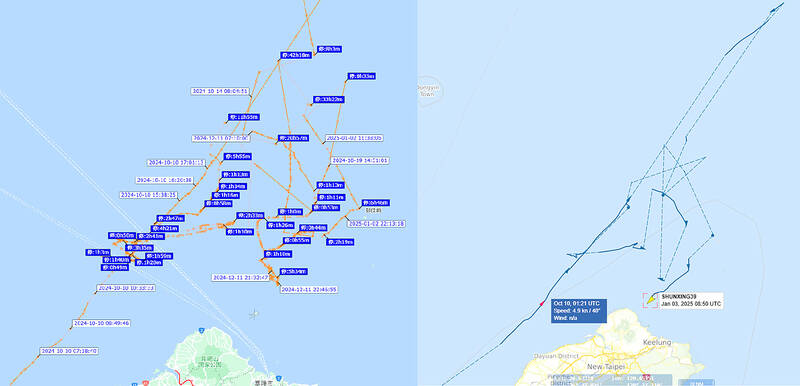A Chinese cargo ship repeatedly intruded into Taiwan’s contiguous and sovereign waters for three months before allegedly damaging an undersea Internet cable off Kaohsiung, a Liberty Times (sister paper of the Taipei Times) investigation revealed.
Using publicly available information, the Liberty Times was able to reconstruct the Shunxing-39’s movements near Taiwan since Double Ten National Day last year.
Taiwanese officials did not respond to the freighter’s intrusions until Friday last week, when the ship, registered in Cameroon and Tanzania, turned off its automatic identification system shortly before damage was inflicted to a key cable linking Taiwan to the rest of the world.

Photo: Courtesy of HiFleet and Vessel Finder
The owners of the Shunxing-39 in November last year retroactively declared that the ship on Sept. 28 had departed from South Korea’s Busan for the Port of Keelung, according to China-based My Ship Tracking.
Keelung had no record of the freighter’s arrival.
The China-based HiFleet showed that the Shunxing-39 transited the Taiwan Strait on Sept. 28 and moved toward China’s Guangdong Province without approaching Keelung.
The ship did not stop in any ports before returning to its unknown point of origin.
Records from ship trackers indicated that the freighter on Oct. 10 entered the northern bounds of Taiwan’s contiguous zone, which is 24 nautical miles (44km) from its coast, sporadically deactivating its automatic identification systems.
The ship’s transponders remained deactivated for minutes to several hours each time.
The following day, the Shunxing-39 sailed toward 26° north latitude before changing course.
On Oct. 19, the ship’s transponder signal vanished about 9 nautical miles west of Pengjia Islet (彭佳嶼) and reappeared in the same area on Dec. 5, making circles.
The Shunxing-39 on Friday last week crossed into the nation’s 12-nautical-mile territorial waters and turned off its automatic identification system again following reports of damage to the undersea cable.
The captain of the Chinese ship later told the Coast Guard Administration that it would return to South Korea, which cannot be verified, as its transponder has remained disengaged.
The Chinese cargo ship traveled 439 nautical miles with an average speed of 3.07 knots (5.7kph) without interference from the navy or the coast guard, records showed.
The navy’s and the coast guard’s new protocol is to use the 24-nautical-mile line to divide their areas of responsibility, the Ministry of National Defense said.
The navy would be responsible for detecting large ships outside of that area, while coast guard radar would monitor the waters inside, it said.
Taiwan should use buoys to mark the waters within 50m of Internet cables as a restricted zone to guard them, former navy squadron commander Jiang Hsin-biao (江炘杓) said in a recent newsletter published by the Institute for National Defense and Security Research.
Repeated incidents involving damage to undersea cables show the importance of using satellites and microwave links to ensure access to key communications systems, he said.
Additional reporting by CNA

Beijing could eventually see a full amphibious invasion of Taiwan as the only "prudent" way to bring about unification, the US Department of Defense said in a newly released annual report to Congress. The Pentagon's "Annual Report to Congress: Military and Security Developments Involving the People's Republic of China 2025," was in many ways similar to last year’s report but reorganized the analysis of the options China has to take over Taiwan. Generally, according to the report, Chinese leaders view the People's Liberation Army's (PLA) capabilities for a Taiwan campaign as improving, but they remain uncertain about its readiness to successfully seize

Taiwan is getting a day off on Christmas for the first time in 25 years. The change comes after opposition parties passed a law earlier this year to add or restore five public holidays, including Constitution Day, which falls on today, Dec. 25. The day marks the 1947 adoption of the constitution of the Republic of China, as the government in Taipei is formally known. Back then the Chinese Nationalist Party (KMT) governed China from Nanjing. When the KMT, now an opposition party in Taiwan, passed the legislation on holidays, it said that they would help “commemorate the history of national development.” That

Taiwan has overtaken South Korea this year in per capita income for the first time in 23 years, IMF data showed. Per capita income is a nation’s GDP divided by the total population, used to compare average wealth levels across countries. Taiwan also beat Japan this year on per capita income, after surpassing it for the first time last year, US magazine Newsweek reported yesterday. Across Asia, Taiwan ranked fourth for per capita income at US$37,827 this year due to sustained economic growth, the report said. In the top three spots were Singapore, Macau and Hong Kong, it said. South

Snow fell on Yushan (Jade Mountain, 玉山) yesterday morning as a continental cold air mass sent temperatures below freezing on Taiwan’s tallest peak, the Central Weather Administration (CWA) said. Snowflakes were seen on Yushan’s north peak from 6:28am to 6:38am, but they did not fully cover the ground and no accumulation was recorded, the CWA said. As of 7:42am, the lowest temperature recorded across Taiwan was minus-5.5°C at Yushan’s Fengkou observatory and minus-4.7°C at the Yushan observatory, CWA data showed. On Hehuanshan (合歡山) in Nantou County, a low of 1.3°C was recorded at 6:39pm, when ice pellets fell at Songsyue Lodge (松雪樓), a